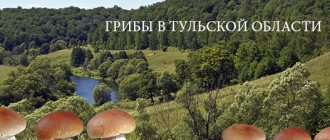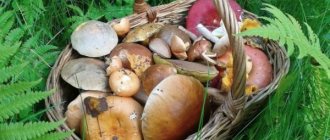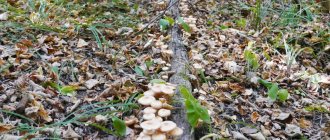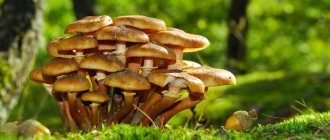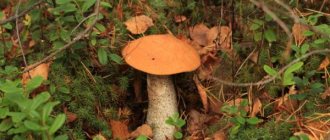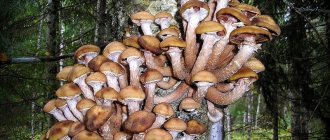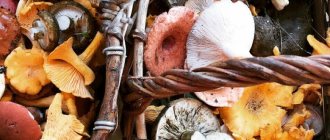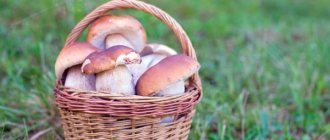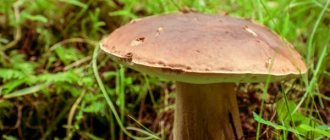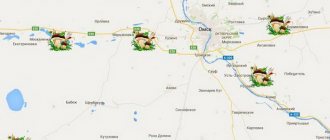Mushrooms in the Chelyabinsk region in 2022, as in the past few years, are harvested in kilograms, making it possible to obtain a harvest not only for food, but also for preparations for the winter. There is an abundance of edible and conventional species, suitable for making pickles, pickling and even pates. Depending on the value of the pulp, the fruits are processed according to various recipes, focusing on reviews and recommendations left under recipes on forums, culinary sites and even social networking groups. The most important thing is to go on a quiet hunt in rainy weather, when the level of humidity in the region increases, activating the growth of mycelium.
Mushrooms area
All types of mushrooms common in Russia grow in the Chelyabinsk region. They are conventionally divided into categories according to suitability for use:
- poisonous, inedible. Such specimens can cause poisoning and even death. Eating is prohibited and dangerous;
- conditionally edible, which can be dangerous if improperly prepared or combined with alcohol. They can accumulate heavy metals and poisons, so eating them is not recommended;
- edible. Mushrooms in this category are not dangerous to life and health, have a pleasant taste and aroma, and can be eaten without fear.
To eliminate the possibility of incorrect collection, you need to know well all the mushrooms growing in a particular area.
Coat of arms and flag of the Chelyabinsk region
Application
Mushrooms are used in different ways. First of all, for food. They are rich in vitamins, microelements and minerals and are beneficial for the human body.
Forest mushrooms are successfully used by pharmacists and doctors to create medicines and treat certain diseases. Mushrooms are also widely used in folk medicine. Our ancestors knew very well about the properties of many of them. This knowledge has been preserved in the memory of some clans, which use it to save people.
In cosmetology, mushroom extracts are used to create rejuvenating and moisturizing masks.
In livestock farming they are used to create feed, and in agriculture they are used for better rotting of silage pits and compost heaps.
Edible
In the Chelyabinsk region there are many varieties of mushrooms that are eaten. They are collected at any time of the year, depending on the ripening season.
Porcini
Porcini
A noble representative of the species with a pronounced smell and taste. It has a massive leg and a fleshy cap of cream or brown color.
When collecting, you need to pay attention to worms, since the porcini mushroom is often affected by forest worms. The affected specimen will have to be thrown away; it is not suitable for consumption.
Summer honey fungus
Honey fungus
Honey mushrooms grow in damp, dark areas on stumps and rotten fallen trees. In the Chelyabinsk region there are meadow mushrooms growing in clearings and meadows. Honey mushrooms always grow in groups on thin legs, have a thin cap and skirt, and the color is closer to brown.
The danger of picking a mushroom is that it has a false double.
ATTENTION! False honey mushrooms are distinguished by their reddish color and the absence of a skirt.
Honey mushrooms can be fried, boiled, pickled and salted. In any form, mushrooms have a pleasant taste.
Russula Food
Russula
This mushroom can be eaten almost raw if it is well salted. However, it may resemble a poisonous mushroom in appearance due to its bright color. Russulas come in red, yellow and even green.
They can be prepared in different ways: from frying to salting. If you feel a slight bitterness, soak the mushrooms in salt water for about 1 hour before cooking.
ATTENTION! If the russula is very bitter, it is better to throw it away, it may be false.
Raincoat
Pear-shaped raincoat
This mushroom grows in fields, near forest plantations, and meadows. It often looks like a ball without a stem and can reach impressive sizes. The growth of raincoats is especially active when humidity is high. The upper skin often develops scales, but sometimes remains smooth and white.
Before cooking, the raincoat is cleaned and rinsed well. In the Chelyabinsk region, they can grow so large that one specimen can fry a full frying pan.
Chanterelle
Chanterelles
They are distinguished by their orange color and the shape of a funnel on a massive stem. The cap is not pronounced due to its special shape and smoothly merges into the stem. Chanterelles are used to make soups, sauces, dressings, they are fried, pickled and salted. It has a pleasant mushroom taste and aroma.
IMPORTANT! The false chanterelle has a very bright orange color and a thin leg.
Real oil can
Oiler
It is distinguished by the oily texture of the cap with the release of droplets on it. It has a brown cap on a thick white stem. Often the butter dish is completely covered with mucus, so before cooking it needs to be cleaned, rinsed and soaked in salt water.
Pine boletus
Boletus
Often found in deciduous plantings or forests. The boletus has a massive white leg, a brown or brick-colored fleshy cap, the inside structure of which resembles a sponge.
Boletus is valued for its size, pleasant mushroom taste and aroma. You can prepare it by frying, boiling, adding to soup, sauce, etc.
boletus
A mushroom with a brown cap, similar in structure to a sponge. Often found in birch forests and plantings in the Chelyabinsk region. In terms of preparation and processing, we go to boletus and porcini mushrooms.
boletus
Common champignon
Champignon
It grows in fields, meadows, a few meters from plantings. The champignon has a white cap and stem. Under the cap the scales are pink or pale brown. When cut, the stem changes color from white to pink or brown.
Expert opinion
Gennady Sergeevich Rylov
A great expert in mycology and an avid mushroom picker. Knows everything about mushrooms, their types and places of growth
To avoid confusing a champignon with a toadstool, you need to look under the cap. The toadstool has a white cap underneath, while the champignon has a pink or brown cap.
Autumn oyster mushroom
Oyster mushroom
A flat cap that turns into a stem and is attached to a tree, stump, or fallen branch. They always grow in groups that look like a fan. The color is gray, the smell is pleasant mushroom. Oyster mushrooms can be fried, boiled, or stewed.
Real morel
Morel
A mushroom whose name determines its appearance. The hat is flat or umbrella-shaped, with many folds, “wrinkled”. The leg is medium thick, brown in color. Grows in heaps and groups in dark and moist deciduous forests.
Ryadovka
It grows along forest plantations, at a distance of 2-3 meters. If you find one copy, there will definitely be more nearby. Often a whole basket can be collected from one mushroom. The rows are dark brown in color, small in size, with a wide but not thick stem.
1-Row green-yellowish 2-Row spruce
Ryzhik
This mushroom is rightfully classified in the first category. The cap of the saffron milk cap is reddish-red on top with a funnel-shaped depression in the center. The lower part of the cap seems to be made of orange plates. The leg is short, also orange, hollow, and looks like a ring when cut. At the break of the mushroom, orange-red juice immediately releases. You touch the orange plates, give them a little squeeze, and they immediately turn green. Rizhik, unlike other mushrooms, is incomparably fragrant.
And it did well in terms of calorie content. If we talk about the calorie content in 100 g of product, then salted saffron milk caps are superior to pickled porcini mushrooms by 67 calories, dried boletus mushrooms by 8 calories, and chicken meat by 75.7 calories. The French used to be sent bottles of salted saffron milk caps from the Urals from Russia. In Paris they were valued more than champagne. They are such saffron milk caps.
Inedible
In the Chelyabinsk region there are mushrooms that, although they are not directly poisonous, eating them can end in disaster. They absorb poisons from the soil or poison the body in small doses when consumed systematically.
Fat pig
Pig
The mushroom is difficult to notice in fallen leaves and on the ground due to its dark, almost black color. It has a flat cap, wide on a short, thick stem.
Pork was once considered a completely edible mushroom, suitable for cooking after soaking. It is now known that the mushroom contains a substance that disrupts kidney function.
False honey fungus
False honey mushrooms
They grow in the Chelyabinsk region and create a danger for inexperienced mushroom pickers to collect and eat. They differ from edible ones in that they do not have a skirt and are red in color, causing poisoning. The probability of error is high, since false ones can be very similar to safe ones.
Russula emetic
Russula emetic
It is almost impossible to distinguish from edible mushrooms by eye even for an experienced mushroom picker. The difference is the bitter taste, which makes the mushroom unpleasant to eat. If such a taste is felt during testing, you must throw out the entire dish.
Consumption rate
It must be observed: too high a concentration of antiseptic is harmful to leaves and roots.
Processing beds
How to treat the soil with potassium permanganate?
- For 10 liters of water heated to 70°C you will need 5 g of potassium permanganate. What to do if you don’t have scales at hand? One level teaspoon is 13.5 g. Therefore, you need to measure out a little less than half.
- The solution must be stirred until not a single undissolved crystal remains.
- Pour it into a watering can and pour the solution over 3-4 m² of garden beds or the same area of soil in the greenhouse, distributing the product evenly. In this case, only the top layer of soil is wetted. To completely treat the soil, you will have to additionally use a solution of another fungicide. If you use a hot solution to cultivate the soil between rows of strawberries in early spring or pour it on currant and gooseberry bushes before the buds swell, there will be fewer pathogens and pests on them - the hot solution will simply destroy them.
The soil is also treated with potassium permanganate locally before planting seedlings. To do this, just pour a liter jar of solution into each dug hole. How to dilute manganese to treat the substrate for seedlings? The proportions for diluting the solution in this case are the same. It is better to spill the soil placed in seedling containers or cups. It would be a good idea to disinfect peat tablets as well.
The soil for indoor plants is disinfected in the same way.
For seeds and seedlings
An antiseptic solution for seeds is needed so that no pathogens remain on their surface. Its concentration is 0.5%; 0.5 g of the substance is dissolved in 100 ml of water. The seeds are immersed in the solution for 20 minutes. You can’t keep them in it longer: they can get burned and their germination rate will decrease. For the same reason, seeds should be washed after disinfection.
For potatoes, prepare the following solution - 1 g of potassium permanganate per 10 liters of water - and soak the tubers for half an hour. The addition of just 2 g of copper sulfate will enhance the disinfection effect.
To prevent the fungal disease, “black leg,” the seedlings will have to not only treat the soil with manganese, but also water it once a decade with a solution of 3 g of the drug per 10 liters of settled water. Don't forget to treat the sowing containers if you use them multiple times.
Poisonous
In the Chelyabinsk region there are a lot of mushrooms that are dangerous to eat. They cause severe poisoning, hallucinations, and death.
fly agaric
A red cap with white spots and scales on a thick stem attracts attention immediately. It has an unpleasant medicinal odor, which may or may not be present.
Expert opinion
Gennady Sergeevich Rylov
A great expert in mycology and an avid mushroom picker. Knows everything about mushrooms, their types and places of growth
You can’t pick such mushrooms, much less eat them. Fly agarics cause severe hallucinations, poisoning, loss of consciousness, and death.
Fly agaric red
Death cap
Death cap
In terms of lethality, even the fly agaric is surpassed. If a small piece of toadstool gets into your food, it will cause severe poisoning and have a negative impact on your health in the future or lead to death.
The toadstool has a thin umbrella-shaped cap and a long thin white leg. If you pull out a toadstool, you will see the volva - the “bag” from which it grows. The plates below the cap are white; the stem does not change color when cut. There may be no smell at all.
Yellow-skinned champignon
Yellow skinned champignon
It looks like an ordinary champignon, but has yellow spots or inclusions of fibers on the cap. When cut, it can change color to bright yellow. It is difficult to distinguish it from its edible counterpart by sight or smell.
An unpleasant odor appears during the cooking stage. Consumption of such a mushroom can cause severe poisoning.
Satanic mushroom
It is similar in shape and size to white, but has a bright red, yellowish, light green or red-brown color. The cap is massive, fleshy, the leg is thick.
The smell, putrid and repulsive, helps to distinguish it from edible food. However, the smell is not always noticeable, so care must be taken when collecting.
Satanic mushroom
Butter
There are several types of them. But in the taiga forests of Siberia and the Urals, the main one is oiler, or, as it is also called, granular oiler. Its cap is covered on top with a yellowish-brown or brown thin but dense film, which is easily removed. But in damp weather, the film on the cap becomes sticky and slimy.
In young fungi, the edges of the cap are connected to the stem by a white film, which over time comes off the cap and remains on the stem in the form of a dark ring. The spongy part of the cap is tender, light yellow, the stem is short. The flesh of the oiler is cool. When you take this mushroom in your hand, it’s like a piece of fresh butter from the refrigerator.
What is collected by month in spring, summer, autumn
In the Chelyabinsk region, mushrooms can be found at any time of the year, but you need to know when which ones grow.
| season | mushrooms |
| spring | May row, morel, porcini mushrooms appear |
| Summer | Champignon, honey mushrooms, white |
| Autumn | Honey mushrooms, rows of mushrooms, boletus, chanterelles, russula, oyster mushrooms, boletus, boletus |
| winter | Honey mushrooms, oyster mushrooms |
For “silent hunting” in the Chelyabinsk region you need to know not only the places, but also the types of growing mushrooms. This will avoid poisoning and more severe consequences. You need to prepare for the gathering, study the theory and find a good place.
Kyshtym-Ozersk highway, Kasli city
Chelyabinsk forests are rich in plants
Near the Kyshtym-Ozersk highway there are popular mushroom places in the Chelyabinsk region.
In deciduous forests there are capsicums and milk mushrooms. The coniferous forests along this region of the area tend to have a lot of butterweed. On the other side of Lake Irtyash, on its northern side, is the city of Kasli, in the forest near which mushroom pickers in Chelyabinsk and the region often go for milk mushrooms and milk mushrooms.
VISHNEVOGORSK
You can collect saffron milk caps near Cherry Mountain. This is a very tasty mushroom that is suitable for frying, pickling and other mushroom dishes.
photo from the site: https://sostavproduktov.ru/produkty/griby/ryzhiki
It’s very pleasant to collect them, because saffron milk caps have no poisonous counterparts! Their reddish color makes them easy to spot among grass or foliage. And between gatherings you can climb Cherry Mountain, from where you can admire amazing autumn landscapes!
ARGAYASH DISTRICT
The Argayash region, especially the forests near the village of Bayramgulovo, are rich in chanterelles. These bright and very tasty mushrooms love to settle both in the grass and on the edges of the forest. They are not afraid of drought or rainy weather. Most often, chanterelles are “caught” in areas of pine forest, which are rich in the Argayash region. When you see one mushroom, don’t take steps, take a closer look! These mushrooms are sociable and love to grow in whole families.
photo from the site: https://sostavproduktov.ru/produkty/griby/lisichka
On warm August days in the Argayash region, you could pick blueberries, which the children would like. And you can diversify your family outing in the fall by playing football or other ball games, because there are many spacious clearings here.
